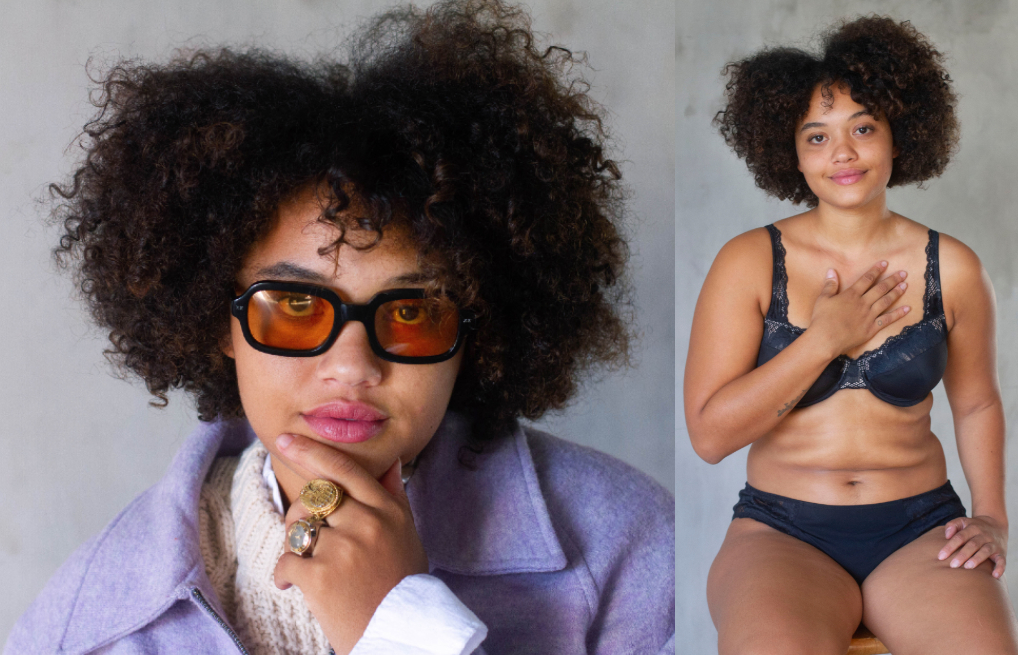
Leon Ford (Credit: StyleLikeU)
Vulnerable storytelling has a spellbinding way of allowing us to see beyond a person’s exterior and straight through to their heart, something Elisa and Lily deftly navigate in the Black Voices series. The magic of Elisa Goodkind and Lily Mandelbaum’s “What’s Underneath” project forces its participants to strip down physically and emotionally. The end result being an emotional undressing of past traumas and experiences.
“I’m done with the struggle. I just want to enjoy my body now.” As this self-aware statement left the red headed woman’s lips it was evident that she meant it; the woman in question was Lizzo before she became the Lizzo we know her to be today. This version of Lizzo was from 2015, which now feels like eons ago because of how self-conscious she seemed in her own skin during her StyeLikeU “What’s Underneath” interview. As I continued to watch her answer mother-daughter duo Elisa and Lily’s questions, it struck me how nervous and body conscious she was.
One of the key factors of the “What’s Underneath” interview is to take off an item of clothing at a time until you’re left at your most vulnerable – naked, or as close to it as YouTube allows. This girl (2015 Lizzo) was unfamiliar to me and the more I watched, it became clear she was still searching for herself–the interview’s unconventional approach actually seemed to be helping.

Leon Ford (Credit: StyleLikeU)
We are at our most vulnerable when we are naked in the presence of others, and it becomes a truth serum of sorts because there is nowhere to hide. And as absurd as this may sound, it’s actually a liberating experience. For over six years Elisa and her daughter Lily have used their platform to share raw, honest and diverse stories of role models across the globe. The premise of the docu-style interview is to share stories on a human level, that allow us to focus on shared experiences and similarities rather than our differences. It started as a rebellion against the fashion and beauty industry that Elisa had worked in for years. She wanted to hold the industry accountable for their role in selling insecurity and dangerous beauty standards, but it became something even bigger.
When the pandemic began, like the rest of the world, the “What’s Underneath” project was hit with a seven-month break, then came the painful protests last June following both George Floyd and Breonna Taylor’s murders. The duo felt compelled by the movement that followed these murders to dedicate their next series to Black voices only, and so their 10-part series “What’s Underneath: Black Voices” was born. The compelling project exclusively focuses on highlighting some of the people we either looked up to at the height of the Black Lives Matter protests or individuals who faced adversities so life changing they’ve dedicated their lives to activism.
Related Articles:
Remembering the Three C’s When Parenting Queer Children
10 Books on Self-Love
Tommy Oliver’s 40 Years a Prisoner is a Story of Love, Family, and Resilience
In one of the recent episodes, we meet Leon Ford, a Black man whose fatal and traumatic experience with the police is unfortunately a tale as old as time. Driving home from a cousin’s house in 2012, a then 19-year-old Ford made the mistake of making eye contact with an officer speeding down the wrong side of the road. After unlawfully stopping Ford and trying to detain him, he tried to leave and was shot several times which left him paralyzed from the waist down. As Ford removed layer after layer all the while sitting in his wheelchair it’s hard not to marvel at how he wears his experience not as a burden but as a positive life changer. Leon Ford’s story isn’t the first or the last, and Elisa says, “the only way to break and burn the system down is to put this [and stories like it] in people’s faces.”
By continuously telling these stories, Elisa and Lily hope to dispel the thought that struggle is a myth or a façade. Pain looks different for everyone and affects even the people who may look like they have it all. Actress Kiersey Clemons’ episode was an intimate look at a woman who was able to make sense of her bipolar diagnosis whilst learning to love herself. Clemons doesn’t look like what she’s been through and because her story is so unexpected it’s all the more important that she shared private life moments in hopes of helping someone. “The purpose of all of this is just to really destigmatize everything, and also to empower people because as long as people are feeling that someone else has it all, and they don’t then we remain separate,” says Elisa.

Kiersey Clemons (Credit: StyleLikeU)
The powerful series will continue running through March with more stories from people like non-binary activist Janaya Khan and Ceyenne Doroshow a matriarch in the Transgender community. The Black Voices edition of StyleLikeU’s “What’s Underneath” project is the kind of storytelling we need right now to continue to champion change and they’re only just getting started.


